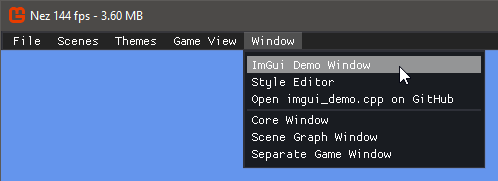ImGUI is an immediate mode UI used to very quickly and cleanly create development GUI to debug your content, or to create custom editors/inspectors for your game.
Enabling ImGUI
For a basic ImGUI inspector in Nez there are 2 things you need to do, first of which is to reference Nez/Nez.ImGui/Nez.ImGui.csproj in your Game’s .csproj:
<ItemGroup>
<!-- If the include isn't your path to nez, make sure to change it below! -->
<ProjectReference Include="..\Nez\Nez.ImGui\Nez.ImGui.csproj" />
</ItemGroup>
And the in your Core implementation add the Nez.ImGuiTools.ImGuiManager to the list of Global Managers.
using Microsoft.Xna.Framework;
using Microsoft.Xna.Framework.Input;
using Nez;
using Nez.ImGuiTools;
public class GameCore : Core
{
override protected void Initialize()
{
base.Initialize();
var manager = new ImGuiManager();
// Optionally you can make it toolbar only!
// This doesnt remove anything that you cant re-enable in game while you debug.
manager.ShowSeperateGameWindow = false;
manager.ShowCoreWindow = false;
manager.ShowSceneGraphWindow = false;
RegisterGlobalManager(manager);
manager.SetEnabled(false); // Turn it off right after if you don't need to immediately use it.
Scene = new Scene();
}
}
Using ImGUI Directly
You may have noticed that you cannot use ImGUI directly, this is because the ImGui Framework that Nez uses is not re-exported. To use the ImGUI Library directly its recommended to add a reference to it to your Game’s .csproj:
<ItemGroup> <!-- Remember this doesnt have to be by itself, you can add this to any ItemGroup -->
<PackageReference Include="ImGui.NET" Version="1.71.0" />
</ItemGroup>
Note: It is very important that you specifically install 1.71.0 as it is what Nez uses under the hood. Anything else could have type mismatches.
And you can now directly use the ImGUI by registering draw commands. As an example in an arbitary Scene:
using ImGuiNET;
using Nez;
using Nez.ImGuiTools;
namespace GameSource.Scenes
{
public class ImGuiExample : Scene
{
ImGuiWindowFlags flags;
public ImGuiExample()
{
flags = ImGuiWindowFlags.MenuBar | ImGuiWindowFlags.AlwaysVerticalScrollbar;
}
public override void OnStart()
{
base.OnStart();
var manager = Core.GetGlobalManager<ImGuiManager>();
manager.RegisterDrawCommand(DrawImGuiPanel);
manager.SetEnabled(true);
}
void DrawImGuiPanel() // No return type, no parameters.
{
ImGui.Begin("Panel Name", flags);
if (ImGui.Button("Log"))
{
Debug.Log("Button was pressed");
}
ImGui.End();
}
}
}
Learning more about ImGUI
If you’re curious on what ImGUI can do, or how to do it, Nez by default includes a demo window that shows off everything that ImGUI can do, you can cross reference this panel with everything inside this file. The method names are the exact same and pointers are replaced with ref.

 Nez Docs
Nez Docs